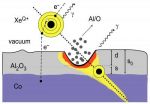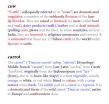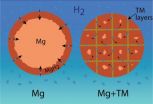(Press-News.org) It's not often that someone can claim that going from a positive to a negative is a step forward, but that's the case for a team of scientists from the National Institute of Standards and Technology (NIST) and private industry. In a recent paper,* the group significantly extended the reach of their novel microfluidic system for analyzing the chemical components of complex samples. The new work shows how the system, meant to analyze real-world, crude mixtures such as dirt or whole blood, can work for negatively charged components as well as it has in the past for positively charged ones.
In previous work,** NIST researchers Elizabeth Strychalski and David Ross, in collaboration with Alyssa Henry of Applied Research Associates Inc. (Alexandria, Va.), demonstrated the use of a technique called GEMBE (for "gradient elution moving boundary electrophoresis") for analyzing complex samples. The NIST-developed system combines a simple microfluidic structure (two reservoirs connected by a microchannel), electrophoresis (which uses electricity to move sample components through a fluid) and pressure-driven flow.
Analyzing complex samples can be difficult because components in these samples (such as the fat globules in milk or proteins in blood) can "foul" or contaminate microfluidic channels. The traditional solution has been to remove contaminants with costly, time-consuming sample preparation prior to analysis.
GEMBE solves this problem by pumping fluid through the microchannel using a controlled pressure in the direction opposite to electrophoresis. This opposing pressure-driven flow acts as a "fluid gate" between the sample reservoir and the microchannel. Gradually reducing the pressure of the counterflow opens the "gate" a little bit at a time. A specific sample component is detected when the pressure flow becomes weak enough—i.e. the "gate" opens wide enough—that the component's electrophoretic motion pushes it against the pressure-driven flow and into the channel for detection. In this way, different components enter the channel at different times, based on their particular electrophoretic motion. Most importantly, the channel doesn't become fouled because the unwanted components in the sample are held out.
"Previously, we validated the GEMBE technique by quantitatively analyzing components from complex samples in solution that were cationic [positively charged] and could, therefore, be separated relatively easily from anionic [negatively charged] contaminants in a mixture," Strychalski says. "However, we needed a way to make GEMBE work when both the desired components and the contaminants are negatively charged."
For some samples, Strychalski says, this was achieved by choosing a different solution pH to change the electrophoretic motion of the unwanted components. In other cases, the addition of commercially available surface coatings to the sample did the trick without compromising the ease and robustness of the GEMBE technique.
"Additives can be selected that will interact with material in the sample that we don't want to study," Strychalski explains. "If we choose the right coating, it will slow the electrophoretic motion of contaminants relative to the desired components. This prevents the former from interfering with analysis while still allowing the latter to enter the microchannel for detection."
Strychalski and her colleagues plan to continue refining the GEMBE system, including an effort to define which surface coatings optimize the technique for specific components in a variety of complex samples.
INFORMATION:
* E.A. Strychalski, A.C. Henry and D. Ross. Expanding the capabilities of microfluidic gradient elution moving boundary electrophoresis for complex systems. Analytical Chemistry, Vol. 83, No. 16, pp 6316�. Aug. 15, 2011.
** See "'No Muss, No Fuss' Miniaturized Analysis for Complex Samples Developed" in NIST Tech Beat, Nov. 17, 2009, at www.nist.gov/public_affairs/tech-beat/tb20091117.cfm#gembe.
Researchers expand capabilities of miniature analyzer for complex samples
2011-09-01
ELSE PRESS RELEASES FROM THIS DATE:
Ion armageddon: Measuring the impact energy of highly charged ions
2011-09-01
Much like a meteor impacting a planet, highly charged ions hit really hard and can do a lot of damage, albeit on a much smaller scale. And much like geologists determine the size and speed of the meteor by looking at the hole it left, physicists can learn a lot about a highly charged ion's energy by looking at the divots it makes in thin films.
Building upon their work for which they were recently awarded a patent,* scientists at the National Institute of Standards and Technology (NIST) and Clemson University have measured the energy of highly charged ion impacts on a ...
Solar industry responsible for lead emissions in developing countries
2011-09-01
Solar power is not all sunshine. It has a dark side—particularly in developing countries, according to a new study by a University of Tennessee, Knoxville, engineering professor.
A study by Chris Cherry, assistant professor in civil and environmental engineering, found that solar power heavily reliant on lead batteries has the potential to release more than 2.4 million tons of lead pollution in China and India.
Lead poisoning causes numerous adverse health effects, including damage to the central nervous system, the kidneys, the cardiovascular system, and the reproductive ...
Word association: Princeton study matches brain scans with complex thought
2011-09-01
In an effort to understand what happens in the brain when a person reads or considers such abstract ideas as love or justice, Princeton researchers have for the first time matched images of brain activity with categories of words related to the concepts a person is thinking about. The results could lead to a better understanding of how people consider meaning and context when reading or thinking.
The researchers report in the journal Frontiers in Human Neuroscience that they used functional magnetic resonance imaging (fMRI) to identify areas of the brain activated when ...
Iron 'Veins' Are Secret of Promising New Hydrogen Storage Material
2011-09-01
With a nod to biology, scientists at the National Institute of Standards and Technology (NIST) have a new approach to the problem of safely storing hydrogen in future fuel-cell-powered cars. Their idea: molecular scale "veins" of iron permeating grains of magnesium like a network of capillaries. The iron veins may transform magnesium from a promising candidate for hydrogen storage into a real-world winner.
Hydrogen has been touted as a clean and efficient alternative to gasoline, but it has one big drawback: the lack of a safe, fast way to store it onboard a vehicle. ...
Registration Opens September 1 for 4th Annual Renton FilmFrenzy, a 50-Hour Filmmaking Competition with $1,700 in Cash Prizes; Filmmakers will Take Over Renton from Oct. 7-9
2011-09-01
It will be "lights, camera, action" in Renton from October 7-9, when aspiring, ahead of the curve filmmakers take over the city for the fourth annual Renton FilmFrenzy, a 50-hour filmmaking competition. Last year, 25 filmmaking teams competed for $1,700 in cash prizes and the coveted Curvee Awards.
"Thanks to our partnerships with SIFF, Reel Grrls, theFilmSchool, area filmmaking programs, and the Renton Arts Commission, the Renton FilmFrenzy continues to expand and has become an integral part of the growing and strong Renton arts community," said ...
Sandfly saliva provides important clues for new Leishmaniasis treatments
2011-09-01
Bethesda, MD—For millions of people who live under the constant threat of Leishmania infection, a new discovery by Brazilian scientists may lead to new breakthroughs, preventing these parasites from taking hold in the body or reducing the severity of infections once they occur. In a new report appearing in the Journal of Leukocyte Biology (http://www.jleukbio.org), scientists show that specific molecules found in the saliva of the sandfly—a small flying insect that is the vector for the parasite—make it possible for Leishmania to evade neutrophils and live within human ...
Celebrate the Seventh Annual Cobra Polo Classic Benefiting Ronald McDonald House Charities
2011-09-01
Polo is possibly the oldest sport, period. The first experience with a mallet, pony and a round object were recorded nearly two thousand years ago. Polo is the sport known to royalty around the world.
On Sunday, September 11th over twelve-hundred guests will celebrate the seventh annual Cobra Polo Classic benefiting Ronald McDonald House Charities of Spokane. "It is the most prestigious event in the Inland Northwest," reports Mike Forness, RMHC of Spokane Executive Director. Sky divers, gourmet food and wine, cigar and Dry Fly whiskey tent, safari escape women's ...
SER2011 Mexico call to action
2011-09-01
The delegates of the Society for Ecological Restoration´s 4th World Conference on Ecological Restoration (SER2011) congratulate the Parties of the Convention on Biological Diversity (CBD) for their practical and forward looking Strategic Plan 2011-2020, including Targets 14 and 15 in which the Parties have agreed that by 2020, ecosystems of particular importance to water security, human health, and sustainable livelihoods are restored, and their resilience and contribution to carbon stocks enhanced, through conservation and restoration, including the restoration of at ...
2011 AAO-HNSF new oral research daily highlights
2011-09-01
San Francisco, CA – The 2011 Annual Meeting & OTO EXPO of the American Academy of Otolaryngology – Head and Neck Surgery Foundation (AAO-HNSF), the largest meeting of ear, nose, and throat doctors in the world, will convene September 11-14, 2011, in San Francisco, CA.
Featuring more than 386 scientific research sessions, 468 posters, and several hundred instruction course hours for attendees, the annual meeting is a unique opportunity for journalists from around the world to cover breaking science and medical news. Reporters will have access to the latest research and ...
Scientists unravel the cause of rare genetic disease: Goldman-Favre Syndrome explained
2011-09-01
Bethesda, MD—A new research report published in The FASEB Journal (https://www.fasebj.org) will help ophthalmologists and scientists better understand a rare genetic disease that causes increased susceptibility to blue light, night blindness, and decreased vision called Enhanced S-Cone Syndrome or Goldman-Favre Syndrome. In the report, scientists found that the expression of genes responsible for the healthy renewal of rods and cones in the retina was reduced and that this problem originates in the photoreceptors themselves rather than in the adjacent retinal pigment epithelial ...




